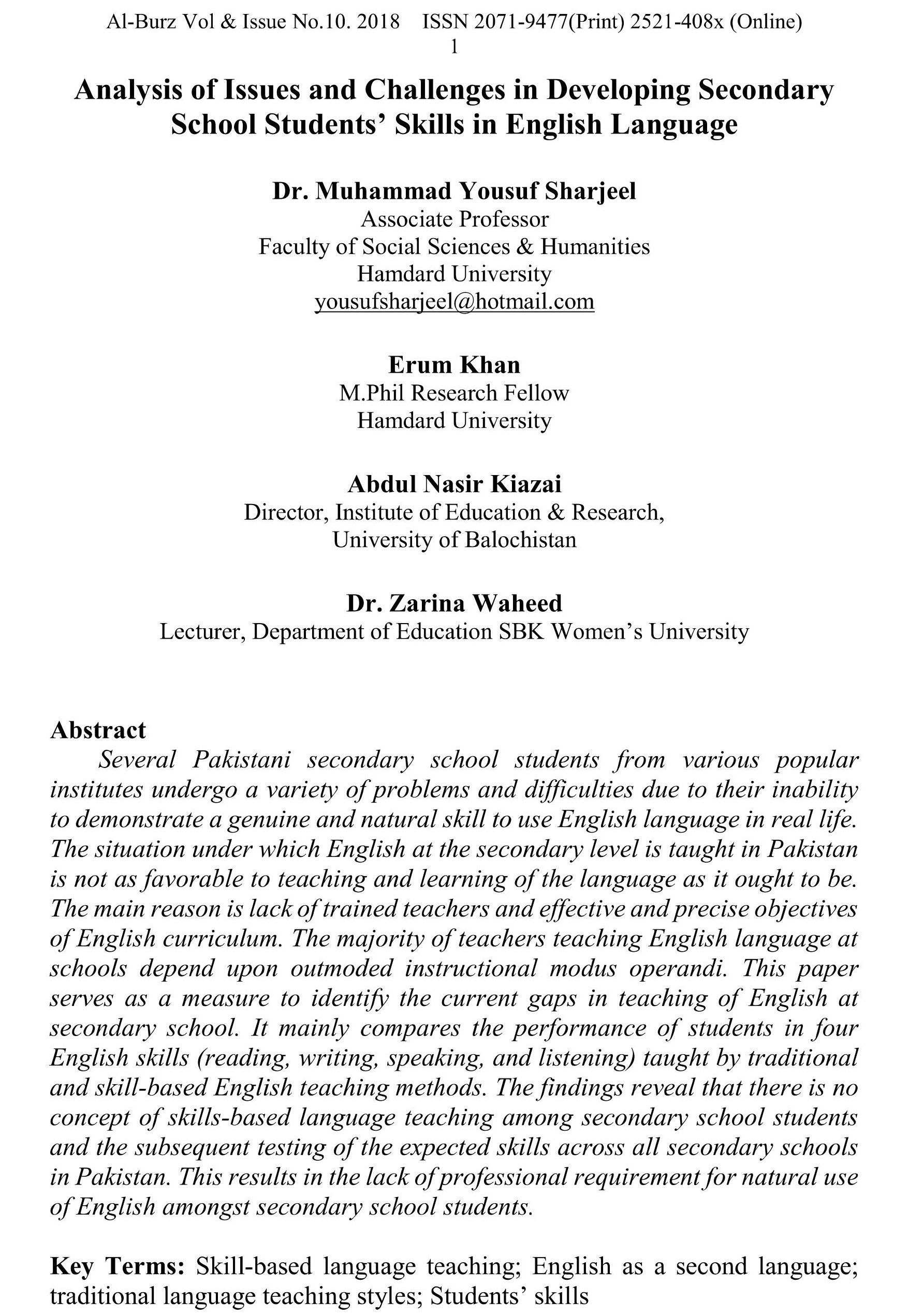Analysis of Issues and Challenges in Developing Secondary School Students’ Skills in English Language
DOI:
https://doi.org/10.54781/abz.v10i1.62Keywords:
Skill-based language teaching; English as a second language; traditional language teaching styles; Students’ skillsAbstract
Several Pakistani secondary school students from various popular institutes undergo a variety of problems and difficulties due to their inability to demonstrate a genuine and natural skill to use English language in real life. The situation under which English at the secondary level is taught in Pakistan is not as favorable to teaching and learning of the language as it ought to be. The main reason is lack of trained teachers and effective and precise objectives of English curriculum. The majority of teachers teaching English language at schools depend upon outmoded instructional modus operandi. This paper serves as a measure to identify the current gaps in teaching of English at secondary school. It mainly compares the performance of students in four English skills (reading, writing, speaking, and listening) taught by traditional and skill-based English teaching methods. The findings reveal that there is no concept of skills-based language teaching among secondary school students and the subsequent testing of the expected skills across all secondary schools in Pakistan. This results in the lack of professional requirement for natural use of English amongst secondary school students.
References
Boonkit, K. (2010). Enhancing the development of speaking skills for non-native speakers of English. Procedia-Social and Behavioral Sciences, 2(2), 1305-1309.
Brown, A. L., Bransford, J. D., Ferrara, R. A., & Campione, J. C. (1983). Handbook of child psychology. P. Mussen, JH Flavell & EM Markman (Eds.), 3, 77-166.
Brown, G. L & Yule, G. N. (1999) Teaching the Spoken Language. Cambridge University Press 1999. Cambridge.
Dunning, David, Johnson, Kerri, Ehrlinger, Joyce, and Kruger, Justin. (2003) Why people fail to recognize their own incompetence. Current Directions in Psychological Science, 12(3). 83-87.
Flavell, J. H. (1979). Metacognition and cognitive monitoring: A new area of cognitive-developmental inquiry. American Psychologist, 34, 906–911.
Gronlund (2000). How to write and use language instructional objectives. (6th Ed.). Prentice Hall. NJ.
Kaplan, R. B. (2001). English – the accidental language of science? In U. Ammon (Ed.) The dominance of English as a language of science: Effects on other language and language communities. New York: Mouton de Gruyter.
Malik, F (2009). The Teaching of English in Pakistan. Lahore: Vanguard. Oxford, R. L., & Cohen, A. D. (1992). Language Learning Strategies: Crucial Issues of Concept and Classification. applied Language Learning, 3, 1-35.
Pintrich, Paul R. (2002). The Role of metacognitive knowledge in learning, teaching, and assessing. Theory into Practice, 41(4). 219-225
Rahman, T. (1999). Language, Education and Culture. Karachi: Oxford University Press.
Rao, Z. (2007). Training in brainstorming and developing writing skills. ELT journal, 61(2), 100-106.
Schellekens, P., & Berry, V. (2013) Setting standards for professional and academic contexts.
Siegel, J. (2013). Second language learners' perceptions of listening strategy instruction. Innovation in Language Learning and Teaching, 7(1), 1-18.
Skehan, P. (1991). Individual differences in second language learning. Studies in second language acquisition, 13(02), 275-298.
Tanner, Kimberly D. (2012). Promoting student metacognition. CBE—Life Sciences Education, 11, 113-120.
Vygotsky, L. (1978) Interaction between Learning and Development. In Gauvian & Cole (Eds) Readings on the Development of Children. Scientific American Books Pp 34-40.
Wu, Jessica RW. "GEPT and English language teaching and testing in Taiwan." Language Assessment Quarterly 9, no. 1 (2012): 11-25.

Downloads
Published
How to Cite
Issue
Section
License
Copyright (c) 2018 Authors who publish with Al-Burz journal agree to the following terms: 1. Authors retain copyright and grant the journal right of first publication with the work simultaneously licensed under a Creative Commons Attribution (CC-BY) License that allows others to share the work with an acknowledgement of the work's authorship and initial publication in this journal. 2. Authors are able to enter into separate, additional contractual arrangements for the nonexclusive distribution of the journal's published version of the work (e.g., post it to an institutional repository or publish it in a book), with an acknowledgement of its initial publication in this journal.Alburz has licensed under a CC Attribution-NonCommercial-ShareAlike 4.0



